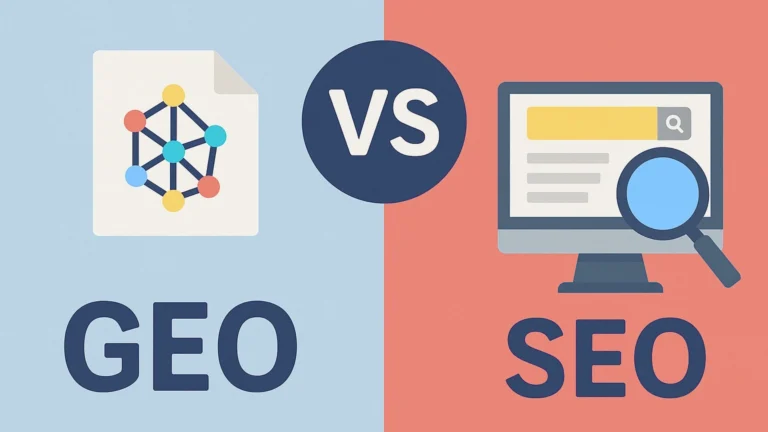Generative Engine Optimisation – The Future of Search and Simple SEO
What is Generative Engine Optimisation? The way people search online is changing very rapidly. With the rise of AI based tools, like Chat GPT and Google’s Search Generative Experience (SGE), businesses are realizing that traditional SEO is not enough. There is a need for arrangements to optimize the content for AI based search engines. To fulfil this need, here comes the role of Generative Engine Optimisation (GEO).
In simple words, Generative Engine Optimisation is about optimizing your content for AI-powered search engines.
Instead of only targeting search engine top links, you also now need to optimize the content so that your content is directly presented in AI-generated answers.
Let us break down what GEO means, how it works, and why it’s critical for the future of digital marketing.
We’ll also explore related concepts like AI-powered content ranking, generative search optimisation, conversational search SEO, large language model optimisation, and prompt engineering for SEO.
Table of Contents
1. What is Generative Engine Optimisation?
Generative Engine Optimisation (GEO) is a technique for making content visible and useful for AI generated responses.
Conventional SEO focuses on higher ranking in search engines while GEO ensures that AI systems understand your content and recommend your content when users ask questions relevant to your content.
In traditional SEO, if someone searches “best travel tips for Italy,” your goal is to rank high on Google. On the other hand in GEO, the goal is to have an AI chatbot to include your tips when generating its answer.
In other words, GEO is about optimizing for AI-first search engines.
2. The Role of AI-Powered Content Ranking
One major shift is that AI systems don’t just look at keywords — they evaluate content quality, context, and authority before deciding what to show. This is called AI-powered content ranking.
Instead of keyword stuffing, you now need to:
- Write content that answers questions clearly.
- Content must be impressive and experience-rich.
- Use proper headings, subheadings, and bullet points where required.
If your article on “healthy recipes” includes expert tips, user-friendly explanations, and references to reliable sources then AI will be more likely to pull your content into its summary.
3. Generative Search Optimisation: How It Works
Generative search optimisation is the process of making your content easy for AI systems to summarize and reuse. Since generative engines look for clarity and depth, your content needs to provide both.
Best practices for generative search optimisation:
- Use FAQ sections to directly answer common questions.
- Write in very simple conversational tone in the way how people ask questions.
- Include updated and factual based information which can be verified.
- Keep sentences simple and short.
While writing content, you have to think about your content as if you are writing to teach a beginner. The easier to understand; the more likely AI will use it.
4. Conversational Search SEO
With voice assistants and AI chatbots growing, conversational search SEO has become a big part of GEO. Instead of short keywords like “best smartphone,” people now ask full questions like:
- “What is the best smartphone for the students under $1000 budget?”
To optimize for this:
- Use natural language in your content.
- Add long-tail keywords that reflect real questions.
- Provide direct, short answers that can be lifted into AI summaries.
According to Google, it is an interesting fact that 27% of the global population uses voice search on mobile devices. This makes conversational search SEO crucial for staying visible.
5. Large Language Model Optimisation (LLMO)
AI bots like ChatGPT , Bard are powered by large language models (LLMs). Optimizing for them — called large language model optimisation — is about structuring your content so these models can easily process and trust it.
How to optimize for LLMs:
- Use clear headings to structure ideas.
- Add references to trustworthy sources.
- Keep the content updated and relevant.
- Avoid vague claims; AI engines prefer data backed information.
When your content is clean, trustworthy, and well-structured, LLMs are more likely to pull it into their answers.
6. Prompt Engineering for SEO
Another new frontier is prompt engineering for SEO. This involves shaping your content so that it aligns with the way people phrase questions to AI systems.
For example, if many users ask:
- “How does SEO impact small businesses?
You should create content in simple language that directly answers the user’s question.
For idea purpose, you can use tools like AnswerThePublic or Google’s People Also Ask section to find common prompts and structure your content accordingly.
Conclusion
Generative Engine Optimisation is not just a buzz word, it is the future of search.
With the growing involvement of AI in the businesses, the businesses that will adapt early will have a huge advantage.
By focusing on AI-powered content ranking, generative search optimisation, conversational search SEO, large language model optimisation, and prompt engineering for SEO, you can ensure your content is ready for the AI-driven world.
SEO is evolving. Ranking on the search engines is still important, but making your content AI-friendly is now also critical. If you want your brand to stay visible in the fast changing digital world, then adopting Generative Engine Optimisation is the right way forward.
FAQs About Generative Engine Optimisation
1. What is Generative Engine Optimisation?
It’s the practice of optimizing your content so that AI-driven search engines and chatbots include it in their generated responses.
2. How is GEO different from traditional SEO?
Traditional SEO focuses on ranking in search engines whereas GEO focuses on being included in AI-generated answers.
3. Why is conversational search SEO important?
Because people now ask full questions instead of typing short keywords, making natural, question-based optimisation essential.
4. What is large language model optimisation?
It’s the process of making content structured, factual, and reliable so AI models can easily use it in their answers.
5. How can I start with Generative Engine Optimisation?
By writing clear, simple, trustworthy and conversational content which directly answers user questions. Adding FAQs, headings, sub headings and credible citations will increase chances of picking your content by AI systems.








